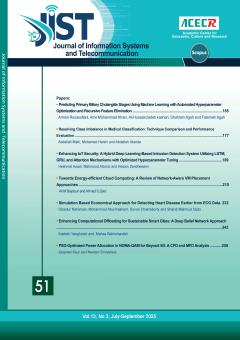PSO-Optimized Power Allocation in NOMA-QAM for Beyond 5G: A CFD and MFD Analysis
محورهای موضوعی : Wireless Network
1 - Institute of Engineering and Technology, Lucknow
کلید واژه: Non Orthogonal Multiple Access (NOMA), Matched Filter Detection (MFD), CFD, PSO, Cognitive Radio Networks (CRN), Next Generation Networks (NGN),
چکیده مقاله :
This paper proposes a power allocation method based on particle swarm optimization (PSO) to enhance spectrum sensing performance in downlink Non Orthogonal Multiple Access (NOMA) systems employing high-order Quadrature Amplitude modulation (QAM) modulation for beyond 5G networks. By intelligently adjusting user power levels, the proposed approach significantly improves detection reliability while maintaining stringent false alarm constraints, even under challenging low-SNR conditions. The goal is to enhance spectrum sensing performance by maximizing the probability of detection (Pd) while maintaining a constrained probability of false alarm (Pf). Cyclostationary Feature Detection (CFD) and Matched Filter Detection (MFD) techniques are applied to evaluate detection performance under varying Signal to noise ratio (SNR) conditions. Simulation results demonstrate that the optimized framework not only strengthens detection performance particularly for high order QAM but also enhances overall system responsiveness. Also CFD surpasses MFD in higher SNR scenarios due to its ability to exploit cyclic features of modulated signals, which are preserved even in moderately noisy environments. The integration of PSO further enhances system performance, offering a practical and scalable solution for next-generation Internet of Things (IoT)-enabled spectrum sharing environments.
This paper proposes a power allocation method based on particle swarm optimization (PSO) to enhance spectrum sensing performance in downlink Non Orthogonal Multiple Access (NOMA) systems employing high-order Quadrature Amplitude modulation (QAM) modulation for beyond 5G networks. By intelligently adjusting user power levels, the proposed approach significantly improves detection reliability while maintaining stringent false alarm constraints, even under challenging low-SNR conditions. The goal is to enhance spectrum sensing performance by maximizing the probability of detection (Pd) while maintaining a constrained probability of false alarm (Pf). Cyclostationary Feature Detection (CFD) and Matched Filter Detection (MFD) techniques are applied to evaluate detection performance under varying Signal to noise ratio (SNR) conditions. Simulation results demonstrate that the optimized framework not only strengthens detection performance particularly for high order QAM but also enhances overall system responsiveness. Also CFD surpasses MFD in higher SNR scenarios due to its ability to exploit cyclic features of modulated signals, which are preserved even in moderately noisy environments. The integration of PSO further enhances system performance, offering a practical and scalable solution for next-generation Internet of Things (IoT)-enabled spectrum sharing environments.
